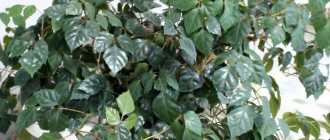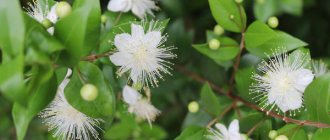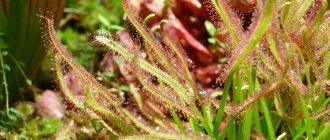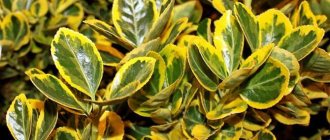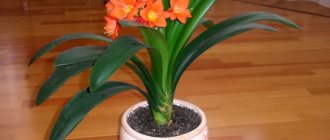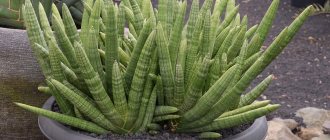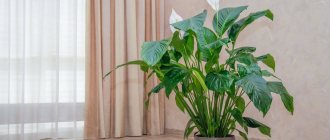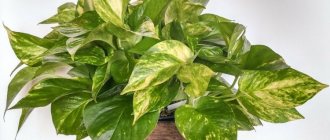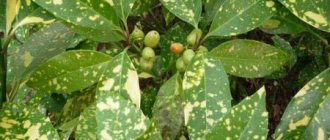Among decorative foliage plants with unusual leaves, rhoicissus has long won the title of classic. In our country, this climbing vine is common under the name “birch” and is considered an almost boring plant. Meanwhile, a talented indoor steeplejack can surprise not only with its unpretentiousness and rapid growth. Roicissus loves cool weather, but at the same time adapts well to ordinary room conditions. Its ideally shaped leaves change depending on the type of plant, do not always resemble birch leaves and delight not with their variegation, but with their impeccable contours. And roisissus itself is an ideal plant for decorating a corridor, hall, foyer, or bright hallway.
Rhoicissus. © eteindien
Botanical description of the plant
Roicissus is an evergreen ornamental deciduous plant characterized by good branching. This liana belongs to the grape family, genus Roicissus, which unites more than 10 different species of liana-like plants. In the wild, it can be found in South Africa, and in the middle zone it is more often grown in greenhouses and as an indoor crop.
Roicissus can reach 2-3 m in length, growing up to 60–100 cm in the first year of life. Leaves are arranged alternately and, depending on the species, can be simple or complex. The trunk is flexible, with small shoots and opposite leaf blades. With age, the trunk vine becomes lignified and more and more resembles a thin grapevine. High branching is the main reason for pruning the plant, without which the leaves may become smaller and the rhizissus will lose its decorative functions. The fruit of rhoicissus is a berry.
Did you know? Tropical forests consist of 33% vines, while in European forest zones no more than 2% of loaches are found, which can be representatives of 200 different species.
Reproduction methods
There are two ways to propagate roisissus:
- Dividing the bush.
- Cuttings.
It is carried out in the spring during transplantation. The plant is carefully divided into two or three parts, depending on size, and planted in separate pots.
Acceptable at any time of the year. The cuttings are cut and planted 3-4 pieces in one container. Blanks should be selected with three to four buds.
REFERENCE: Rooting occurs at a temperature of 20-22 degrees in 20 days. Roicissus quickly begins to produce new shoots and in a short time turns into a lush, beautiful flower.
Main types
The list of possible varieties of the described plant includes up to 12 names, but the following are considered the most common:
- Roicissus rhombicus. In its natural habitat, it is either a vine, up to 20 m long, or a bush, about 6 m wide. The houseplant is much smaller, but consists of the same main parts: light green, leathery, complex leaves with pointed edges and red hairs at the bottom parts; small, round fruits that can be eaten. The color of the fruit is dark red or purple.
- Roicissus capensis - a liana characterized by rapid growth and characterized by large leaf blades, about 20 cm wide. All of them are solid, lobed, smooth on top and reddish, slightly pubescent below. In a young plant they may be reddish, but with age they acquire a light green color. As in the previous case, dark red fruits can be eaten.
- Roicissus tomentosa - a liana-like plant that in tropical forests can reach 20 meters in length or take the form of a bush, up to 7 m in height. In a young specimen, all shoots are softly pubescent, but with age the hairs disappear. The tendrils of the vine are velvety to the touch, the leaves are simple, round, entire, up to 20 cm in diameter. Each leaf plate has shallow teeth at the ends, a slightly wavy, smooth upper side and a lower side covered with red hairs.
Important! When choosing a specific variety for your home, it is advisable to pay attention to the cape and rhombic rhoicissus, since in comparison with other representatives of the genus they adapt more easily to indoor conditions and their growth is easier to control.Young tomentose rhoicissus leaves have a rich dark green color, but with age it gives way to crimson, which persists until the leaf fall period. The flowers are creamy-green in color, small in size, collected in racemes. The fruits are black and red, edible.
- Roicissus tridentata. In its natural habitat, it is represented by a 10-meter vine or a small shrub reaching 3 meters in height. The entire surface of young shoots is covered with orange-red hairs. The leaves are compound (the leaf blade is divided into 3 parts), obovate, slightly serrated at the ends. Above, the dark green surface of the leaf blades is smooth, leathery and shiny, and in the lower part it is lighter and slightly pubescent. The flowers are small, green-yellow in color, with a slight greenish tint. The fruits are red-black, round, up to 2 cm in diameter.
- Roicissus palmata - a liana-like plant, with shoots up to 15 m long or a bush, about 4 m high. The vines of young plants have red-brown hairs, but with age they thin out and disappear. The dark green leaves consist of 4-5 parts, all of them are entire, with a smooth leathery surface on top and “rusty” hairs below. The flowers of the vine are small, greenish-yellow in color. The fruits are black-red, round, 1.5 cm in diameter.
Beneficial properties and harm
First of all, it should be noted that the vine has no harmful effects on the human body; on the contrary, it has a number of benefits that can be useful to completely different people. So, this plant is useful for those who are accustomed to constantly cleaning the house and cannot get rid of the obsessive feeling of excessive cleanliness, the need to restore order.
In terms of maintaining health, indoor birch is appropriate in the fight against gastrointestinal diseases and helps to increase the protective functions of the body, making it more resistant to the negative influences of the external environment.
And finally, roisissus will be an excellent solution for those gardeners who simply want to green up their home, but cannot devote much time to indoor vegetation. With minimal attention, the vine can surprise with its appearance, bringing a certain sophistication to the interior of almost any room.
Also learn about such indoor plants as tetrastigma and alsobia.
Selecting a location
For good health, roisissus needs long-lasting, but not bright, lighting. Direct sunlight is harmful to vine leaves and even with short exposure can lead to a change in their color. Taking this into account, when choosing a place to place a pot, it is advisable to give preference to the south or west side of the house.
During the dormant period, the birch tree can be placed inside the room, maintaining average temperature values within +15°C. In summer, the plant will feel great on the balcony or even outdoors, the main thing is to protect it from direct sunlight and protect it from drafts.
If there is not enough space for the vine near the windows, it can be left away from them. For example, shoots hanging from a pot will look great when placed in floor flower stands located in the corners of the room.
Air temperature and humidity
The optimal temperature for the growth of roisissus will be +16...+25°C during the warm period of the year, and about +12...+15°C during winter dormancy. In this case, the level of humidity in the room does not play a big role and can be maintained within the standard range of 50–60%.
Important! If the leaves of the vine begin to dry out at the tips, it means that the existing humidity level is not enough and you will have to periodically spray the plant with a spray bottle.
Home care
Regular watering, timely feeding and pruning of the plant are irreplaceable components of the good appearance of the rhizissus, so it is useful for every gardener to know about some of the nuances of their implementation.
Watering
Indoor birch prefers frequent and abundant application of soft liquid, without lime impurities and other undesirable additives that can get to the root system along with ordinary tap water. To avoid the accumulation of salts and heavy metals in the soil, it is advisable to first filter or at least settle the water, at the same time raising its temperature to room values.
As for the regularity of watering, you will have to monitor the condition of the top layer of soil: as soon as it dries 1-2 cm deep, you can take up the watering can. Both top and bottom watering are allowed, but in any case, it is better to drain the remaining water from the pan so as not to provoke rotting of the vine’s root system.
In winter, the frequency of watering is usually reduced, but if the room is hot, then this will not be necessary and you can still focus on the condition of the top layer of the substrate. In extreme heat, it is recommended to spray the leaves with a spray bottle, which will not only increase the humidity in the room, but will also rid the plant of accumulated dust.
Important! When trying to determine the norms for watering roisissus, do not forget to take into account the characteristics of its planting capacity. In ceramic pots, water evaporates faster, so the vine will need to be watered more often than when grown in plastic products.
Top dressing
The optimal solution for feeding rhoicissus is to apply liquid fertilizers simultaneously with watering, approximately once every 14 days during the warm season (from March to the end of October). As a nutritional composition, you can use any universal preparations intended for indoor decorative foliage plants (for example, Agricola). If there is a lack of important microelements in the soil, rhoissisus begins to lag in growth, and its leaves quickly turn yellow.
Trimming
Considering the natural length of the vine, pruning is one of the mandatory components of care, especially since the plant itself tolerates any trimming and shaping well. Typically, shoots are pruned to the level desired to limit rhoicissus growth, if possible in early spring. In addition, at this time it is worth carrying out sanitary pruning, removing all bare, thinned or damaged shoots of the plant. If you're worried about cutting them out completely, then just trim them down to the size of stumps.
Support
Many gardeners do not use support to support the thin and fairly flexible shoots of indoor vines, which can significantly harm its appearance. Stable and rigid ladders or trellises, with the help of which gardeners create green screens or even walls, will help to form attractive and densely leafy shoots, although to completely cover the surface you will have to manually guide the shoots, combining tying and pruning, until the desired result is achieved.
Transfer
Annual replantation of roisissus is carried out only in the first few years of development of a young plant, which is explained by intensive growth and rapid consumption of nutrients from the soil. Adult plants are replanted only when necessary, when the previous pot has become small and the roots have completely “mastered” the earthen ball. On average, this takes about 2-3 years.
Did you know? The longest vines are those of the so-called rattan palm, the shoots of which extend from the center to a distance of 200–250 m.
There are no strict requirements for the timing of transplanting a vine, because the procedure can be performed both at the very beginning of its active development and throughout the spring period. The new planting container should be at least 3-4 cm larger than the previous one, so that the plant feels free over the next 2-3 years. A drainage layer must be laid at the bottom of the pot, a support is installed and a small amount of soil mixture is poured from equal parts of leaf and turf soil, humus and half of river sand (the optimal pH level is 6.0).
After this, perform the following transplant steps:
- Remove the plant from the old pot using the transshipment method.
- Place it in a new container and cover it with earth.
- Gently water with a small amount of water.
Video: roiscissus (cissus) transplantation
Immediately after transplantation, it is recommended to carry out watering procedures as often as possible, but using a small amount of liquid to moisten the soil. In the first 2 days, it is recommended to place the transplanted vine in a shady or semi-shaded area, and only after that return it to its usual growing location. It is advisable to wait with fertilizing for at least 4 weeks after transplantation.
Birch tree transplant
Indoor birch trees periodically require replanting. As a rule, this procedure should be carried out once every 3 years. First you need to prepare the substrate. You can buy it in finished form at a flower shop or prepare it yourself. To do this, you will need to take 2 parts each of turf and garden soil, then add part of the humus and the same amount of sand. As for the latter, it must be river and have large fractions. Due to its looseness, such a substrate will allow water, oxygen and nutritional compounds to pass through well.
You also need to choose a pot. It should be larger than the previous one, but not very high. It is best to choose medium-sized containers. If the pot is too large, the additional space will create discomfort for the flower. It is recommended to choose containers made from natural materials. The best option is ceramics.
There should be several holes at the bottom of the container to allow soil to pass through. Be sure to lay a couple of centimeters of drainage layer underneath. Pebbles, expanded clay, broken bricks or tiles, etc. are perfect for this. Before placing a birch flower in a new pot, you need to inspect its roots and remove those that are broken or dry. The bush should be placed in the center of the container, and then sprinkled with soil from different sides. The substrate needs to be compacted, but not very hard. This is necessary so that there is no empty space left around the roots. The roots should be located no deeper than 5 cm below the soil. For the first three days, you should keep the container with the plant in a dark place. Only after this is it possible to install the pot in a permanent place. Be sure to water the flower after transplanting. Use only settled water at room temperature. For the first six months, fertilizing is not required, since there are enough useful substances present in the soil.
How to propagate at home
If there is a mother plant, the most successful option for propagating rhoicissus will be cuttings, since rooting and further development of the taken part occurs faster than germination of seeds. However, you should not completely abandon the seed growing method, because in some cases it turns out to be the only possible one. Let's look at the features of each option.
Cuttings
To get a new plant, the apical part with at least 2 internodes is usually cut off from the mother bush. Of course, only an adult and completely healthy plant is suitable for preparing such cuttings, which will give more guarantees for the successful rooting of the cut part.
Important! Sometimes other parts of the plant obtained as a result of planned pruning can be used to propagate birch trees by cuttings.
The rooting process can take place either in clean warm water or in a mixture of sand and peat, and a plastic cap over the cutting will help speed it up. During the entire rooting period, the temperature in the room must be maintained within +20...+23°C and the cap must be raised only to spray the soil or ventilate the planting material.
After roots appear on the cuttings, they can be transplanted into a regular small pot (no more than 8 cm in diameter) filled with soil for adult plants.
Video: propagation of roisissus by cuttings
Propagation of rhoicissus in this way is almost always successful, because the first roots appear on the planted cuttings within a few weeks. The optimal time for planting planting material is March-April.
It happens that during the process of replanting, a plant can be propagated by dividing the rhizome, but it is advisable to perform this procedure only if you have the appropriate experience, so as not to injure the plant by careless action.
Seeds
The soil for planting indoor birch seeds is prepared according to the same recipe as for adult plants when transplanting. Its composition must necessarily include sand, humus, leaf and turf soil, with the addition of river sand (the optimal proportion is 1/2: 1: 1: 1). It is advisable to deepen the seeds no more than 1 cm, however, even in this case high germination cannot be guaranteed. In indoor conditions, seeds rarely set, and flowering of an adult plant is almost impossible. For this reason, it is advisable to propagate rhoicissus by cuttings.
Reproduction of Rocius
Birch trees have two methods of reproduction:
- Using cuttings. It is best to do this in spring, when new branches appear on the vine. The cuttings should be carefully trimmed so that at least two internodes remain. All cut cuttings should be placed in a container with a damp mixture of sand and peat. After 12-14 days, the plants will be ready to be transplanted into a normal container.
- With the help of shoots. After winter rest, the plant must be cleared of old shoots and slightly rejuvenated. Cut branches can be placed in water until roots appear, and then transplanted into pots with suitable soil.
Additional care. In order for the birch tree to be more magnificent, it is necessary to pinch the tops of the stems. Birch lashes need support, then they develop much faster.
Possible pests and their control
House plants, even the most unpretentious ones, also suffer from attacks by pests, among which are:
- Leaf aphids. Many house plants suffer from these small insects. Getting rid of them is very simple: you need to make a strong solution of laundry soap and spray the flower with it. It is easy to detect aphids; you just need to carefully examine the underside of the leaves.
- Spider mites appear on grassy vines when watering is improper, when the plant lacks moisture. The main sign of the presence of mites is the appearance of small cobwebs on leaves and shoots. You need to fight ticks using a special product sold in stores. In addition, the plant needs to be returned to proper watering.
- Scale insects are a rather dangerous pest for indoor plants. It usually lives on stems and leaves, and is sometimes found on stems. The insects have an oval shape and a flat body, the lower part fits tightly to the plant. There are two types of scale insects: false and true. Real ones know how to hide under their shells, like turtles, but false scale insects do not have this ability. The reproduction rate of scale insects is high, so colonies appear very quickly. They suck the juice from house plants, causing them great harm. If you don’t start fighting them in time, the vine will die. Means for exterminating scale insects can be purchased at gardening stores.
- The fool is white. This insect lives in soil, especially in soil that contains a lot of humus. It has an elongated body on which small antennae are visible. It feeds on plant remains, but does not disdain living roots. Because of this, the plant can become sick and wither, and eventually die.
- Mealybugs. These small worms are white in color and like to settle on the back of leaves, closer to the passing vein. Female scale insects are larger, their size reaches 0.5 cm. They make homes for their numerous offspring; the houses look like cotton balls. Females store eggs in them. Usually these insects do not live on vines, preferring cacti and azaleas to them, but if a birch tree is adjacent to these flowers, they can settle on it.
Possible difficulties during cultivation
Any indoor plant can get sick or reduce its decorative value due to violations of the rules of care, so it is not surprising that when growing indoor birch, a gardener may encounter one of the following problems:
- The color of the leaves fades. The main reason is the lack of useful minerals and microelements in the soil, which should enter the substrate along with fertilizers. Try changing the composition you are using or increasing its dosage.
- Leaves wrinkle and become covered with dark spots, the basis for which is often insufficient watering and excessive dry air. In addition, under such conditions, leaf plates can bend and change shape.
- The leaves dry out and the shoots decrease in size. It may be necessary to reduce the amount of watering and stop spraying for a while, which will help reduce air humidity.
- Excessive leaf loss - a frequent sign of the development of root rot or a consequence of sharp fluctuations in temperature in the room.
- Slow growth. If in the cold season such a phenomenon can be explained by the dormant period of the rhoicissus, then limited growth in summer most likely indicates a lack of nutritional components in the soil. Reconsider your fertilizing plan or change the nutrient composition you are using.
A separate group of reasons for possible problems in growing plants includes the development of fungal diseases and the activity of pests, the most common of which are whiteflies, aphids, spider mites and mealybugs.
In the fight against them, such insecticides as “Akarin”, “Aktara”, “Bikol”, “Fufvnon” are relevant. The fungicides “Mikosan”, “Oksikhom” or “Agate” should help in the treatment of fungal diseases (the required dosage is always indicated on the package). Having put a little effort into growing rhoicissus, very soon you will get an excellent vine that can become a good addition to the interior, but each gardener can decide for himself how and where to place it for greater decorativeness.
Watering mode. Humidity
Birch is a rather unpretentious houseplant and easily adapts to many negative factors, but not to lack of water. The vine should be watered abundantly, but carefully. She does not like excessive moisture and stagnation of water in the pot, and even more so the soil should not be allowed to turn into a dry lump of earth. It is believed that a birch tree needs to be watered every day in summer, and 2-3 times a week in winter, but this is a controversial point. In summer, when the temperature is fairly low and even, the plant may not need to be watered for 2-3 days, but in winter, with active heating, the soil can dry out within a day. So watering indoor plants needs to be adjusted to specific conditions.
But what Cissus rhombifolia will never refuse is a warm shower. Birch, for all its immunity to mild temperature fluctuations, does not tolerate low air humidity. This phenomenon is smoothed out with the help of water procedures: a small plant is watered from the shower in the bathroom, and long vines, which are difficult to move, need to be sprayed more often.
